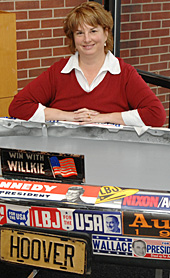Greenlee School grad student says bumper stickers still make mark in current campaign
09-26-08
Contacts:
Patti Brown, Greenlee School of Journalism and Communication, (515) 229-4578, pcbrown@q.com; pcbrown@iastate.edu
Mike Ferlazzo, News Service, (515) 294-8986, ferlazzo@iastate.edu
Anne Kassel, News Service, (515) 294-6881, akassel@iastate.edu
Greenlee School grad student says bumper stickers still make mark in current campaign
AMES, Iowa -- The presidential campaigns have increasingly turned to technology like text messaging, e-mail, blogs and Facebook pages to learn where voters stand on their candidates. But Patti Brown says the old tried-and-true bumper sticker still might be one of the best ways to tell whether a voter is on board.
An Iowa State University graduate student in the Greenlee School of Journalism and Communication, Brown has spent more than a year researching the trends of political bumper stickers and their marketing effectiveness. And she's found they're still relevant to the current presidential campaign.
"The bumper sticker helps voters to make a decision, formalize that decision and make that decision publicly known," said Brown. "Cars in America are a symbol of power and independence and allow us to really 'drive' our opinion home."
Brown says the bumper sticker not only allows voters to show their support for a candidate, but they also can say a lot about that particular voter.
But bumper stickers don't always paint an accurate picture of support. Brown said research suggests that more expensive vehicles are less likely to be covered in bumper stickers, and that more bumper stickers for Democratic candidates appear on vehicles than those supporting Republican candidates.
Among the 2008 candidates, Brown says their bumper stickers are designed differently to connect their message with different voters.
"John McCain's bumper sticker has more of a formal and military look to it through its coloring and use of the star. It sends a strong message and represents credentials to be commander in chief," she said.
"Barack Obama's bumper sticker incorporates the 'O' and is a graphically pleasing image," Brown said. "The 'O' shape integrates his message of hope and the promise of a new era."
Brown also says that the time and era can affect campaign bumper sticker design. This year's stickers are a little different, she said, because neither candidate uses the traditional symbol of the flag or traditional coloring which is red or blue on a white background with a golden yellow accent.
"Candidates are trying to get as many decided voters as early as possible and even though there is no definite proof of political guarantee, bumper stickers allow for voters to become engaged with a candidate," she said.
Brown will graduate in December with her master's degree in journalism and mass communication. Following graduation, she plans to work with Jay Newell, an assistant professor in the Greenlee School, on an empirical study that measures the effectiveness of political bumper stickers.
Brown's blog, "Driving Political Opinion: Presidential Campaign Bumper Stickers" (www.bumpertobumper.squarespace.com) features her research on political bumper stickers.
-30-
